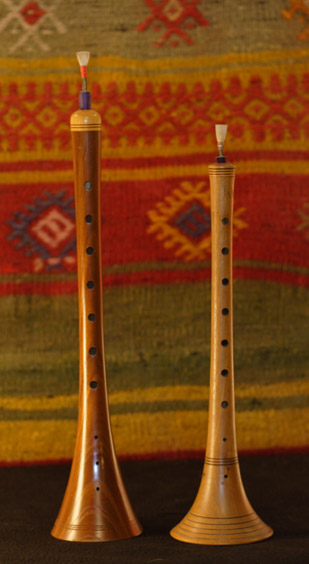Zokra/الزّكرة
الزّكرة أو الصرناية أو الزرنة آلة موسيقية هوائية تعمل بالنفخ تتألف من قصبتين وجسمها خشبي حيث يتم النفخ في القصبتين بواسطة الفم, وهي من الآلات الموسيقية الشعبية في شمال العراق وتركيا وسوريا وإيران في المناطق السريانية ، الآشورية و الأرمنية، ويعتقد أن التسمية فارسية بمعنى (الناي الجهير).تتصف الزرنة بصوت عالٍ جداً لذلك تشكل والطبل ثنائي إلزامي حيث يستخدمان عادة في الاحتفالات الشعبية والأعراس والرقصات الشعبية التراثية في العراء حيث على صوتهما تجري الدبكة
__________________________________________________________________________
zokra, zurna, zourna, zorna, zurla, surnay, surnai, zamr, zamour (en turc: Zurna, en arabe: الغايتة; alghaita, en kabyle : lɣayṭa, en arménien: Զուռնա, en géorgien: ზურნა; zourna), est un instrument à vent à anche double de la grande famille des hautbois dont les origines sont anatoliennes. Elle tire son nom du persan زورنه (zur : fête, corne ou force et ney : roseau). En Afrique du Nord, elle reçoit aussi les appellations suivantes qui proviennent de l'indo européen Gada : algaita, ghaita, rajta, rhaita, etc.
La zokra s'est répandue dans toutes les contrées sous domination musulmane, notamment en Turquie,en Azerbaïdjan, en Arménie, en Géorgie, en Iran, dans les pays arabes (en Syrie, en Irak, au Liban, en Égypte au Maroc, en Algérie), au Niger, en Grèce (aussi pipiza et karamouza) et dans les Balkans. Bien des variantes existent par ailleurs en Extrême-Orient (comme le suona en Chine), en Asie centrale et du Sud-Est et en Inde.
zokra est fabriquée en bois de mûrier, de buis ou d'abricotier. La perce est cylindrique pour la partie supérieure, conique pour le pavillon et rappelle son ancêtre, la corne. Elle a huit trous (dont un pour le pouce et un d'accord). Un petit tuyau de bois fendu est inséré dans le conduit principal afin de guider l'air et afin d'en obturer certains trous éventuellement. L’anche double amovible en roseau plié est fixée à un support de métal, qui lui-même est fixé sur une rondelle protectrice en bronze.
Elle existe en trois tailles différentes de 22 à 60 cm qui sont parfois jouées simultanément selon les pays. Bien souvent le corps de l'instrument est décoré d'appliques en métal et autres pendeloques.
La zokra s'est répandue dans toutes les contrées sous domination musulmane, notamment en Turquie,en Azerbaïdjan, en Arménie, en Géorgie, en Iran, dans les pays arabes (en Syrie, en Irak, au Liban, en Égypte au Maroc, en Algérie), au Niger, en Grèce (aussi pipiza et karamouza) et dans les Balkans. Bien des variantes existent par ailleurs en Extrême-Orient (comme le suona en Chine), en Asie centrale et du Sud-Est et en Inde.
zokra est fabriquée en bois de mûrier, de buis ou d'abricotier. La perce est cylindrique pour la partie supérieure, conique pour le pavillon et rappelle son ancêtre, la corne. Elle a huit trous (dont un pour le pouce et un d'accord). Un petit tuyau de bois fendu est inséré dans le conduit principal afin de guider l'air et afin d'en obturer certains trous éventuellement. L’anche double amovible en roseau plié est fixée à un support de métal, qui lui-même est fixé sur une rondelle protectrice en bronze.
Elle existe en trois tailles différentes de 22 à 60 cm qui sont parfois jouées simultanément selon les pays. Bien souvent le corps de l'instrument est décoré d'appliques en métal et autres pendeloques.
___________________________________________________________________________
zokra, zurna, zourna, zorna, zurla, supernay, superna, zamr, zamour (in Turkish: Zurna, in Arabic: الغايتة, alghaita, in Kabyle: lɣayṭa, in Armenian: Զուռնա, in Georgian: ზურნა; zourna), is a wind instrument with double reed of the great oboe family whose origins are Anatolian. It takes its name from the Persian زورنه (zur: feast, horn or force and ney: reed). In North Africa, it also receives the following appellations which come from the European Indo Gada: algaita, ghaita, rajta, rhaita, etc.
Zokra has spread to all countries under Muslim domination, including Turkey, Azerbaijan, Armenia, Georgia, Iran, the Arab countries (in Syria, Iraq, Lebanon, Egypt, Morocco, Algeria), Niger, Greece (also pipiza and karamouza) and in the Balkans. Many variants exist elsewhere in the Far East (like the suona in China), in Central and South-East Asia and in India.
zokra is made of mulberry, boxwood or apricot. The hole is cylindrical for the upper part, conical for the pavilion and reminds its ancestor, the horn. She has eight holes (one for the thumb and one in agreement). A small split wood pipe is inserted into the main duct to guide the air and to seal some holes. The detachable double reed in folded reed is attached to a metal support, which itself is attached to a protective bronze washer.
It exists in three different sizes of 22 to 60 cm which are sometimes played simultaneously depending on the country. Often the body of the instrument is decorated with metal sconces and other pendants.
zokra, zurna, zourna, zorna, zurla, supernay, superna, zamr, zamour (in Turkish: Zurna, in Arabic: الغايتة, alghaita, in Kabyle: lɣayṭa, in Armenian: Զուռնա, in Georgian: ზურნა; zourna), is a wind instrument with double reed of the great oboe family whose origins are Anatolian. It takes its name from the Persian زورنه (zur: feast, horn or force and ney: reed). In North Africa, it also receives the following appellations which come from the European Indo Gada: algaita, ghaita, rajta, rhaita, etc.
Zokra has spread to all countries under Muslim domination, including Turkey, Azerbaijan, Armenia, Georgia, Iran, the Arab countries (in Syria, Iraq, Lebanon, Egypt, Morocco, Algeria), Niger, Greece (also pipiza and karamouza) and in the Balkans. Many variants exist elsewhere in the Far East (like the suona in China), in Central and South-East Asia and in India.
zokra is made of mulberry, boxwood or apricot. The hole is cylindrical for the upper part, conical for the pavilion and reminds its ancestor, the horn. She has eight holes (one for the thumb and one in agreement). A small split wood pipe is inserted into the main duct to guide the air and to seal some holes. The detachable double reed in folded reed is attached to a metal support, which itself is attached to a protective bronze washer.
It exists in three different sizes of 22 to 60 cm which are sometimes played simultaneously depending on the country. Often the body of the instrument is decorated with metal sconces and other pendants.
Tunisian folk music instruments/Zokra ..................................... ألات موسيقيّة شعبيّة تونسيّة/زكرة
Views:
Category:






0 commentaires :
Post a Comment